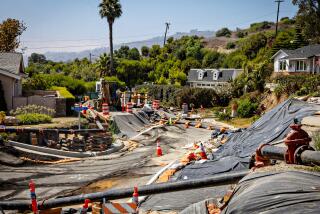Oxnard residents oppose plan for 3rd power plant
As debate rages over two proposed liquefied natural gas terminals off the Oxnard coast, Southern California Edison has announced plans to build a third power station in this seaside city to help prevent blackouts during peak summer demand.
The 45-megawatt generator would be in place by August at Mandalay Bay near two bigger power plants, officials said. It would provide enough power for 29,250 households, much of that for use in Ventura County.
It is one of five units to be installed across the Los Angeles region by summer at a total cost of $250 million. Other sites include Norwalk, Ontario, Stanton and Rancho Cucamonga. Edison officials said scattered sites were selected in part to prevent an earthquake from knocking them all out.
By power plant standards, the new generators are pipsqueaks. In contrast, the existing Reliant Energy power station at Mandalay Bay generates 430 megawatts -- a megawatt is enough electricity for about 700 households. Reliant also operates a 1,500-megawatt power plant at nearby Ormond Beach. The new generators are intended to produce just enough energy to satisfy peak demand.
State Public Utilities Commission President Michael Peevey directed Edison in August to produce an additional 250 megawatts of power by summer 2007. Record heat last year resulted in fatalities and power shortages across Southern California. Extreme heat is forecast this summer, and energy companies are scrambling to prepare.
But many Oxnard residents question why the power station must be built in their city. They argue that Oxnard is already home to two big power plants and is being considered for two proposed offshore liquefied natural gas projects.
Australian resources giant BHP Billiton is proposing to build an $800-million terminal 14 miles off the Ventura County coast, while Houston-based NorthernStar Natural Gas Co. seeks to build a big liquefied natural gas terminal on an oil platform 21 miles offshore. Both facilities would be linked to Oxnard by pipelines.
Liquefied natural gas terminals receive super-chilled natural gas from overseas, heat it to vapor and distribute it to homes and businesses. Gov. Arnold Schwarzenegger and President Bush, as well as many business leaders, support such projects to ensure a reliable energy supply. California air quality regulations favor natural gas, a clean-burning fossil fuel, to fight smog.
Oxnard City Councilman John C. Zaragoza said many of his constituents object to a convergence of energy projects in Oxnard. Many people in the mostly Latino city believe that they are unfairly being exposed to risks and pollution from energy projects without benefits.
“I have a lot of concerns,” Zaragoza said. “We have two current power plants, and then we have the old Halaco [toxic waste site] plant and we are host to three landfills, and now they are proposing LNG off the coast. We need those plants, but why Oxnard? Seems like we have our fair share already. There’s other parts of the coast we can build this [Edison power] plant.”
He said the City Council would probably schedule public hearings on the project this spring. Meanwhile, Edison is sponsoring a public meeting on its new power station from 4:30 to 7:30 p.m. Tuesday at the Courtyard by Marriott near U.S. 101 in Oxnard.
Shirley Godwin, chairwoman of the Saviers Road Design Team, which promotes civic improvements in Oxnard, opposes the new power station. “This is really troubling,” she said. “This is contrary to what we are trying to achieve for Oxnard.”
Mark Nelson, manager of generation planning and strategy for Edison, said the company examined numerous sites before selecting Oxnard. He said a 16-acre site was chosen because it’s near natural gas fuel lines and electrical transmission lines and can be used to help start the adjacent Mandalay Bay generating station. Further, Nelson said, Oxnard is a rapidly growing community with increasing energy needs.
Nancy Lindholm, president and chief executive of the Oxnard Chamber of Commerce, said local businesses favor new power sources to ensure reliability. “For business and industry and our quality of life, it is essential that we have an adequate energy supply,” she said.
Nelson said the new power station is a $50-million turbine similar to ones used on jet engines. It would be powered by natural gas rather than aircraft fuel and contained in a sound-reducing building. In industry parlance, the unit is called a “peaker” because it typically runs during emergencies or when electrical demand is at its peak, such as hot summer afternoons, to supplement the big power plants.
While turbines are generally not as efficient as power generating stations, their advantages are that they can be started and stopped in minutes to respond to energy demand immediately and can be installed much faster than big power plants.
Nelson said that Edison is scheduled to begin building the power station in April and that it would be in operation by August.
More to Read
Sign up for Essential California
The most important California stories and recommendations in your inbox every morning.
You may occasionally receive promotional content from the Los Angeles Times.










